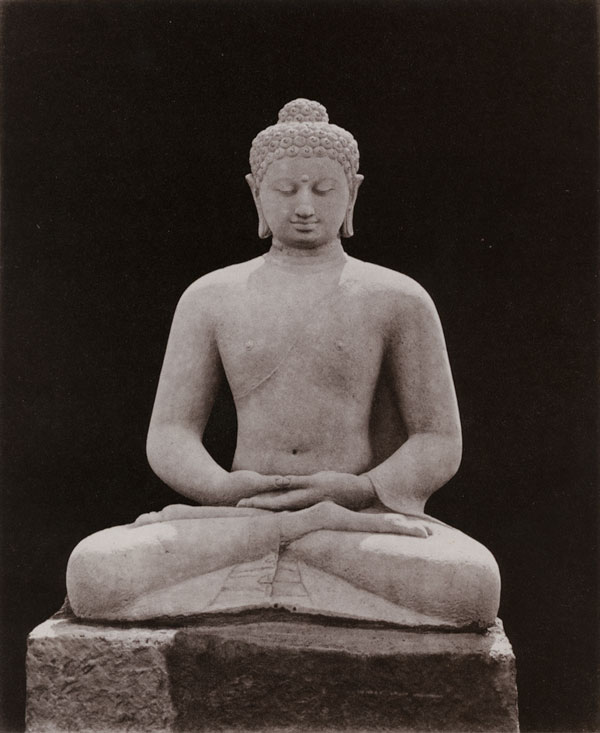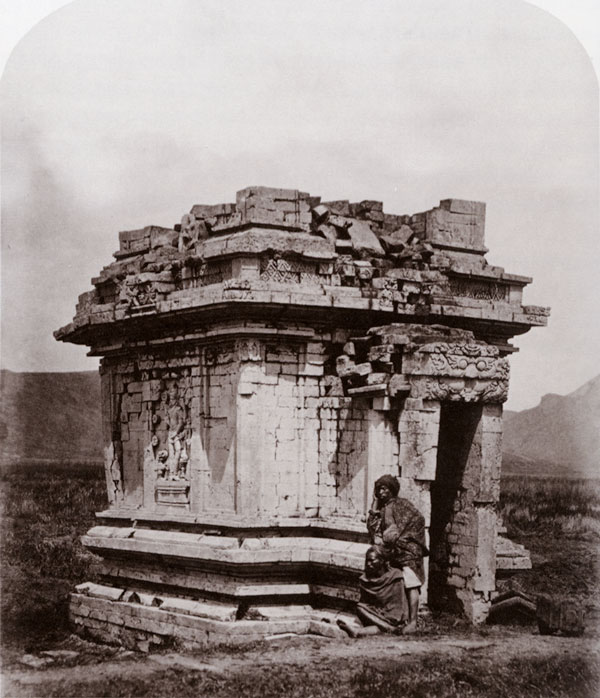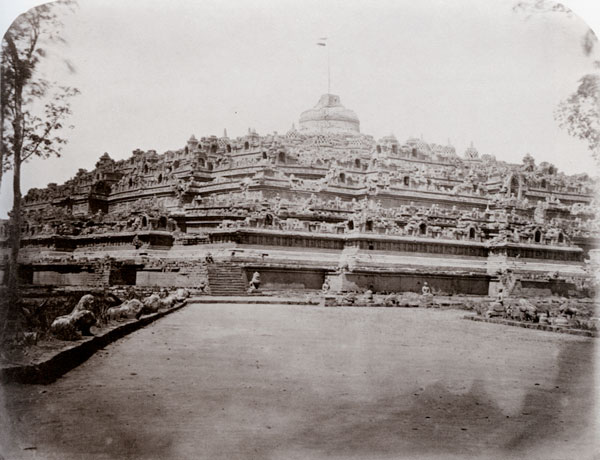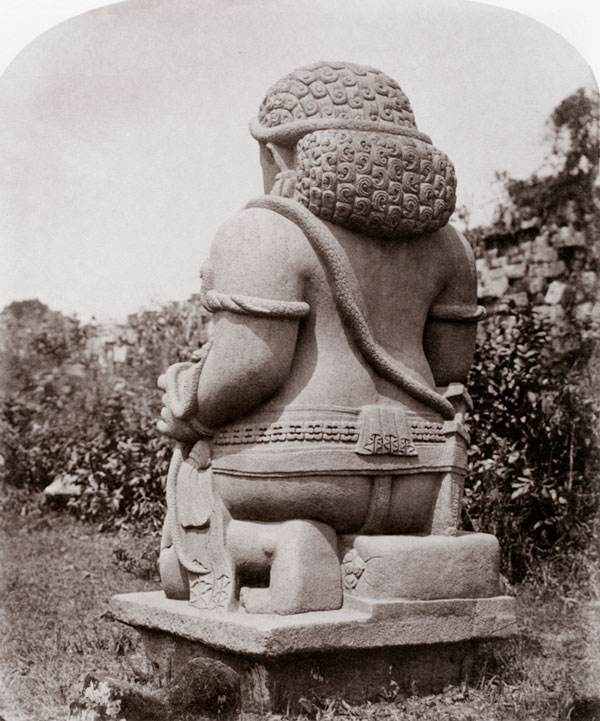 |
Isidore Von Kinsbergen
Seated Buddha Amitabha statue, west side of Borodubur, c.1863-1866. Albumen print. |
During the nineteenth century, there was a growing awareness among Europeans in the Dutch Indies of the importance of Javanese antiquities, which consist mainly of temples made of volcanic stone housing stone images of hindu and buddhist divinities, sacred bathing places and caves cut out of the rock. These shrines are adorned with decorative motifs and often with narrative reliefs. Other items of interest are small figurines of deities cast in bronze or precious metal; ritual implements made of metal, such as water vessels, bells, lamps, incense burners, mirrors and golden jewelry; records engraved on copper plates or on stones; decorative parts of domestic buildings; terta-cotta objects for domestic use; and manuscripts on palm leaves. These telics date roughly from the fifth to the sixteenth centuries.
The Batavian Society of Arts and Sciences (Bataviaasch Genootschap voor Kunsten en Wetenschappen), which was founded in 1778, played a pivotal role in stimulating research of these antiquities. Often with financial support from the government of the Dutch East Indies, the Society dispatched representatives to make records of these remains and included descriptions and drawings in survey reports. With the development of photography in the middle of the nineteenth century, it was only natural that the Society should look to this new medium to further its interests.
In Isidore Van Kinsbergen they found the photographer they were seeking.
Van Kinsbergen had arrived in Batavia in 1851 to take up a position as an ornamental painter and actor at the theater. He earned a living during the day by painting the scenery of the stage on which he appeared in the evenings.1 As a photographer, he was self-raught. A few years after arriving in Java, he had come across a book on photography by chance and decided ro master this new craft.
Early in 1862, he was asked to be the official photographer for a diplomatic mission to Thailand that was headed by the Secretary-General of the Dutch East Indies, Alexander Loudon. Later that year, he accompanied the Governor-General, Sloet van de Beele, on a trip through Java and Bali. The photographs he took on these journeys, which were made with the collodion wet-plate process, were shown to the Directors of the Batavian Society as evidence of Van Kinsbergen's abilities. They met with great approval, and at the end of 1862 he was commissioned by the government, through the Batavian Society, to photograph Javanese antiquities under the direction of an antiquarian, the Revetend J.F.G. Brumund.2 Brumund, who had started his archaeological trip in May 1862, died suddenly in March 1863, but it was decided that the photographer should proceed on his own.
Van Kinsbergen sent his photographs back to Batavia in batches as they were made. He would go to a site and stay for some weeks or months to photograph. He soon found himself confronted by a number of unforeseen problems, the greatest of which was that hardly any of the antiquities were in a fit state to be photographed. His report on the condition in which he found the temples on the Dieng Plateau and the measures he took to improve them is recorded in the minutes of the Batavian Society.3
Much of the plateau was now a swamp, although the ancient Javanese had apparently constructed a good drainage system. After some trial and error, Van Kinsbergen was able to dig an outlet for the water with the help of coolies. In addition, not only were the temples overgrown with masses of vegetation, but the ground level had risen by up to one-fourth of the height of the temples. Sculptures were often covered with dirt or tar, which first had to be removed. Also, many of the antiquities were hard to reach—on mountains or in dense forests—and the weather did not always provide the kind of light that was required. It took him a total of seventy-two days to take sixty-two photographs on the Dieng Plateau.
Only two-thirds of the job had been completed when his contract expired in May 1866, but it was extended for another year.4 When that year was up, many "final notices" were still needed before Van Kinsbergen could be persuaded to complete his commission. When he finally delivered the last photographs, the entire committee was extremely satisfied with the result. It was decided that prints of each negative would be made and assembled into portfolios called Antiquities of Java. These were sent to King William III of the Netherlands, to the custodian of Javanese antiquities of the Museum of Antiquities (Museum van Oudheden) in Leiden and to learned societies in London, Paris and Calcutta. Arrangements were also made so that copies of the photographs could also be ordered by anyone interested.5
In spite of the almost endless delays in completing this job, the Society soon gave Van Kinsbergen another commission, this time to take photographs of sculptures and reliefs of Borobudur, which had not been included in the previous project.6
Van Kinsbergen set off in April 1873 and finished the job on June 1,1874.7
At Borobudur he found obstacles such as loose stones and a thick layer of earth on the floors of the galleries, settling floors and defective drainage. After some preliminary excavation, he was rewarded with the discovery of about two hundred reliefs. A problem here he had not encountered before was the narrowness of the galleries, a peculiarity of the structure that others had also confronted. He assembled a stand that could be pushed in front of each relief in such a way that the lens was at the correct distance from the object, but even so the preparation of one negative sometimes took ten days.8
Van Kinsbergen's photographs generally met with approval. The Directors of the Batavian Society had continuing faith in him despite his endless delays, and they always applauded his work. The pictures were made known to a wider public beginning in 1876 by P.J. Veth, professor of ethnology at the Leiden University, in a series of articles in the popular journal Eigen Haard, each of which reproduced one of Van Kinsbergen's photographs as the centerpiece.
Today, specialists in the field not only frequently use his photographs for reference, but often do so with admiration. The photographer's greatest admirer, though, was the archaeologist G. P. Rouffaer, who never missed a chance to praise his work. In a 1901 review of a book of the arts of the Dutch East Indies by E. A. von Saher, who had included images of plaster casts, Rouffaer made a special point of lauding Van Kinsbergen's photographs to the skies.9
There was one diehard critic of Van Kinsbergen's photographs, however, Dr. C. Leemans, director of the Museum of Antiquities in Leiden. In 1858, the Dutch government asked Leemans to prepare a book on Borobudur using the architectural plans, sections and drawings of the sculptures and reliefs made by F. C. Wilsen between 1849 and 1857 (these had been commissioned by the government after the failure of the daguerreotype experiment), a paper written by Wilsen, and a 1857 article by the Reverend Brumund. With great perseverance and after surmounting many difficulties, Leemans succeeded in completing his task.
In 1873, the book, consisting of four immense volumes of plates and two smaller volumes of text, was published by E.J. Brill in Leiden. In a letter to the Directors of the Batavian Society, Leemans commented on the portfolios of Van Kinsbergen's Antiquities of Java, which he had just received. He said that the work was not complete and that he would like to receive the missing photographs. In general, he found the photographs too full of contrast in the blacks and whites to provide a proper idea of the objects, and he felt that a measuring rod should have been added in each photograph. Finally, as a general objection to the medium of photography, he remarked that the objects were shown from just a single viewpoint in a false perspective, which made it necessary to add plans and sections for clarity. Then he came to his real point: Now that his own book had appeared, why was it necessary to commission Van Kinsbergen to document Borobudur photographically?10
In the meantime, a third party had involved himself in the discussion. The well-known Dutch critic, Conrad Busken Huet, who lived and worked in Java from 1868 to 1878, had little interest in things Javanese, but he now took Van Kinsbergen's side. In a short and sharp article in the March 1875 issue of rhe Economist, he reduced the dispute to a simple statement: Leeman's work is pedantry, Van Kinsbergen's is art.
The only just criticism of Van Kinsbergen's photographic series is that they do not provide a complete survey of Javanese antiquities. He included many so-called Polynesian images that are of no relevance to Javanese archaeology, but these are, however, charming pictures. He also completely omitted photographing several important temple sites. On the other hand, photographs of archaeological importance, such as a dated sculpture of Ganesha, show this deity so charming in his compactness that it has become one of Van Kinsbergen's most popular photographs. It is also a good example of his technical control; he often blackened the background of sculptures without disturbing their form in order to make them stand out.
Isidore Van Kinsbergen continued to live and work in Batavia until his death in 1905. He became famous for his photographs of antiquities, but he also did popular subjects such as Javanese portraits and landscapes.11
In the circle of Europeans living in Batavia, however, he was more famous for other talents. No major festivity was conceivable without Van Kinsbergen's support. He decorated the rooms and was the driving force behind each party.
Likewise, he was the moving spirit at the theater. He organized and produced plays, and in 1875 he invited a French opera group to come to Java.12 These pleasures of Batavian social life likely contributed to his delays in completing his photographic commission, but he was still the best choice to do it. There was no one more suited for the job.
NOTES
- Batavian Nieuwsblad, 30 August 1901, 2.
- Minutes of the Batavian Society, The Hague, 1862, 5-6, 40-41, 57-58, 145-147.
- Ibid., 1864, 262-269.
- Ibid., 1866, 158, 184, 249.
- Ibid., 1872, 16-18.
- Ibid., 40.
- Ibid., 1874, 71.
- Ibid., 71-73.
- Rouffaer, G.P., Monumentale Kunst op Java "De Gids", vol. 2, 1901, 225-252.
- Minutes of the Batavian Society, 1873, 102-106.
- S. Wachlin, in Toekang Potret: 100 Years of Photography in the Dutch Indies iSyo-ioio, Amsterdam & Rotterdam, 1989, 183.
- Praamstta, Olf, "Een Indisch Toneelstuk", Maatstaf, April 1986, 130-156.
 |
Isidore Von Kinsbergen
Punta Dewa temple (c. 750 AD), Dieng Plateau, Cental Java, 1864. Albumen print. |
 |
Isidore Von Kinsbergen
General view of Borodubur with Dutch flag, c.1873. Albumen print. |
 |
Isidore Von Kinsbergen
Ganesha with a crown, from Candi Bara (1239 AD), A Java Hindu Temple, near Blitar, East Java,
1863. Albumen print. |
 |
Isidore Von Kinsbergen
Gupolo, guardian of Sewu temple (780 - 790 AD) near Prambanan, Central Java,
c.1863-1868. Albumen print. |
| next paper | about Pauline Lunsingh Scheurleer
| contents page | asia-pacific photography | photo-web | contacts
|